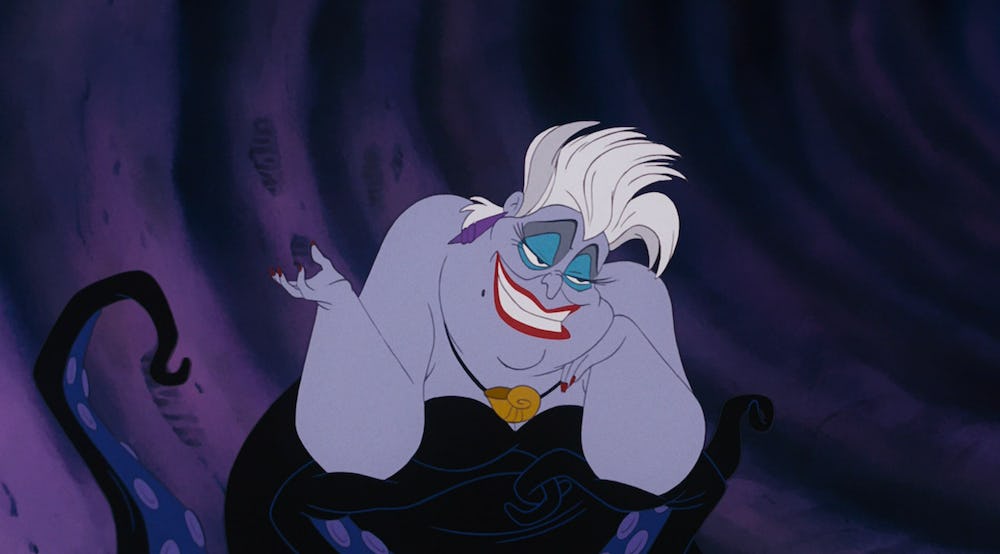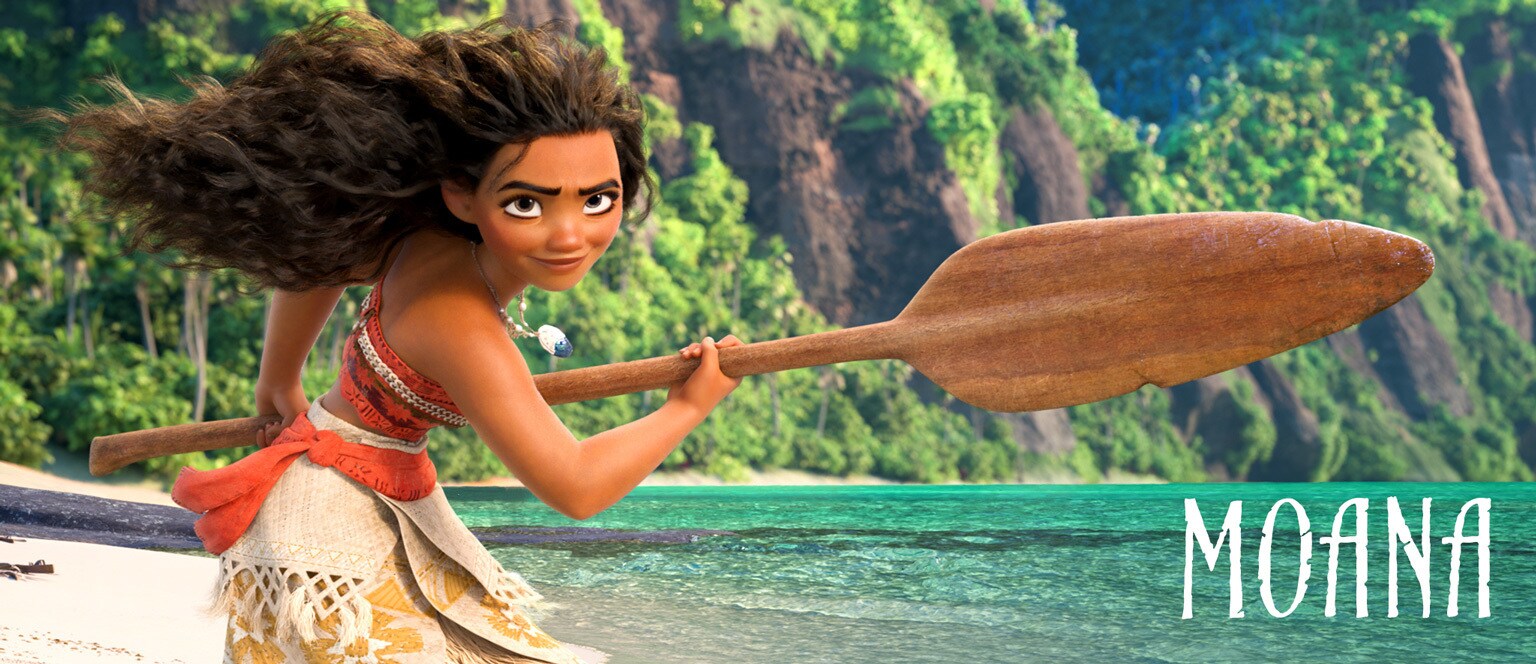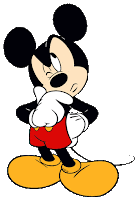
Sunday, February 26, 2017
Friday, February 24, 2017
Transgender villain
Although
villains in Disney comes from different imaginations, they always have similar
characteristics and appearance: harmful, deviant appearances, and abnormal
actions. However, many similarities are under the same category, transgender behavior.
As
Putnam stated in Mean Ladies, many Disney
villains exhibit transgender identities, or lack of gender identifications. For
example, Anastasia in Cinderella as a young lady seems over masculine with her
large feet and lady Tremaine’s facial features and behaviors mark her as both
unfeminine as well as unmotherly.
Sometimes,
females that are overly feminine are also marked as villains. Ursula in the Little mermaid is an example of
overly feminist with large breasts and abnormal body appearances.

However,
male characters that are overly masculine are rarely criticized in Disney’s
films. In Beauty and the Beast, the Beast is portrait as a character that is a
hero in its heart; however, such quality does not apply to female over-feminist
characters. One may conclude that sexism is at present in early Disney’s films.
I
found Putnam’s passage to be effective and her viewpoint seems unique to me.
Her analysis on Disney villains is able to identify the ill relationship
between gender identity and morality. I am surprised at how clear Putnam
showcased Disney’s strategy in villain building and it certainly brought a refresh
experience to me.
Do
I blame that Disney characterized villain as people who have transgender identity?
It is a hard question to answer because transgender is a minority in society
and for Disney it just seems to be the easiest way to signal audiences who the
identification of characters in movies. Human are based on value appreciation
from society and the more qualities that are similar, the easier to be
appreciated. On the other side, minority identity group are not at advantage in
modern society because they have less in common with the majority.

I
can understand Disney’s motives behind its approaches, but they do not
necessarily present accurate messages. People have different genetics and
Disney’s ideal of perfection is a misleading information for younger
generation. As Putnam discussed, creating villains that are based on heroines
is irresponsible. Even more, with constant reinforcements, such messages will
eventually become a natural reflexes for audiences not only in movie watching
but also in real world interactions.
However,
Disney is an enterprise that focuses on the interests of the majority. It is to
their interest to maximize revenue by creating films that reinforces public
opinions. As time passes, it is clear to see through Disney’s films that they
follow the trend of society instead of breaking it. Its first African princess
film Moana, is a result of gradual
equalization between races in US. Disney produces entertainment by creating a
world of perfection and magic, will it gain as much success by challenging the
currents of society?

It
is hard to break off a negative moral spiral, and it is even more so when financial
interests are involved. Disney has massive cultural power considering its
impact toward children and its earlier recipes of villains should be carefully
amended to entertain and instruct younger audiences. And base on its recent
progression, I am certain that Disney is able to achieve this goal.
Information on new Disney movie can be seen here, and let us hope that Disney can constantly improve its message toward the youth
Monday, February 20, 2017
Cinderella(1950): A classic film for now and always
As one of the most
beloved animated Disney films in 1950, Cinderella has left a deep impression
for me. I watched the reboot of Cinderella a few years ago and it is hard to
believe the 1950s had such amazing visual designs. The stylings of Cinderella
produced by Mary Blair gave such a magical, dreamlike quality that makes me
engage into the movie.


Although it did not have the most realistic ideology,
"No matter how your
heart is grieving, if you keep on believing, the dream that you wish will come
true",
the story itself is instrumental for children’s development and
being optimistic is helpful in dealing with situations.
As a wonderful and almost flawless tale, Cinderella’s small
characters such as Bruno the dog, Lucifer the Cat and especially Gus the mouse
certainly added an element to the beloved story.
The wonderful music and sounding in the movie helped to evoke
audiences’ emotions and affection to certain characters.
The usage of color contrast between villains(step mother, the
cat) and Cinderella is decisive and can easily create character stereotypes as
the bright and dark side of the story.
 I appreciated the brilliant animation, the clever plot
turns and humors. The animation is very well done, and brings me right into the
scene with characters. The animation also does well portraying the styles of
the backgrounds, at Cinderella’s home and the grand ballroom of the kingdom.
The humor from the mice is a fundamental element in the movie that was one of
the spotlight in the film
I appreciated the brilliant animation, the clever plot
turns and humors. The animation is very well done, and brings me right into the
scene with characters. The animation also does well portraying the styles of
the backgrounds, at Cinderella’s home and the grand ballroom of the kingdom.
The humor from the mice is a fundamental element in the movie that was one of
the spotlight in the film
The movie is not made
for accurate depictions, but to bring audiences into the life of Cinderella and
see her lovely characteristics and cheerful spirit even in miserable
situations.


Something about this movie just evokes the magic of Disney. And
it was the reason behind further successes in Disney’s films.
Although I do not find
Cinderella as my style of movie, I can see why it had been such a popular
children film in the past half a century and continues to be an ever-lasting
tale.
However, Disney’s films might seemed slightly redundant, where female
characters were always saved by male protagonists. Although Cinderella is an
optimistic, hard-working and loving lady, she is not able to escape from her living
condition and continues to be tormented by her step mother until the Magic of
old lady saved her.
The unrealistic side of magic showed the fact that women at that time
period were still not strong enough to make a difference for themselves and
these messages can be viewed as biased; however, it is an accurate description
of women in 1940s where they required the support from men.
As magical as it seemed, Cinderella is still a product of the
decade and cannot escape some of the biases. However, Disney’s magic is
constantly evolving and its movies nowadays have much more dynamic within the
women characters.
Cinderella is
definitely a classic animation that fully represented Disney’s values in its
production: fun, idealistic, and fantasy-like wonderment, its goals are to
attract, inspire, and entertain youngsters while bring them into a fantasy land
where hope and magic are essential parts of the universe. And the magic
remained in many peoples’ hearts.
Sunday, February 19, 2017
James Earl Jones and Donald Glover to Star in Live-Action Remake of “The Lion King”
The remake of 'The Lion King" will be legendary with these two incredible singers.
More information is here.

More information is here.

Rivers of the light
 Disney's animal kingdom just had a beautiful night time event called "Rivers of the light". The scenes were stunning. For more pictures click here.
Disney's animal kingdom just had a beautiful night time event called "Rivers of the light". The scenes were stunning. For more pictures click here.
Saturday, February 11, 2017
Comparasion between Hiaasen and Giroux
Hiaasen and Giroux, two iconic
critics of Disney, have very different approaches in terms of evaluating the
"evil" deeds of Disney and I found both writing styles to be very
thoughtful and entertaining. People may prefer one over the other, and the
reason behind it is the drastic difference between authors' intended
audiences.
The audiences, Giroux wanted to reach are probably people
who value a critical analysis of Disney. Giroux is able to present the broad
picture of Disney and many negative effects of other multimedia corporations.
He provides logical reasoning against the norm of praising Disney's
entertainments, sometimes using statistical facts and sometimes in discussions
of Disney's social responsibility.
Although some languages in Giroux's articles have a spice
in them, the majority of the passages are objective to the point with a
critical view of capitalism market structure.
Hiaasen, on the other hand, perhaps hoped for audiences who
would enjoyed a good laugh or a chill down the spine. He viewed Disney in a
much closer perspective.
Instead of condemning on the capitalism itself, Hiaasen
provides his own fascinations of Disney combining with facts. Using descriptive
wordings, Hiaasen presented a vivid presentation of how Disney shaped the
United States, if not the world. 

Many examples in the book Team
Rodent are author's first-hand experience with Disney, and
these instances bring proximity to reveal the Disney Hiaasen has in mind:
a self-evolving and expanding mouse that slowly rules the world in every
possible angles. Examples of security team chasing teenagers, investigation on
actors' backstage and invitation of journalist to Disney Land reflex just how
powerful and omnipotent Disney can be.
Of course, wordings in the book are meant to attract audiences’
attention and trigger their emotions, but these event are indeed accurate which
is even more repulsive to think about.
Although their intended readers are different, two authors
are excellent in expressing their own believes. However, sometimes opinions in
the readings are too biased which are hard to follow with furious storms
of attack on Disney. Maybe I might not be the intended reader after all.
Both authors have strong arguments and I
appreciate their efforts in evaluating the issues they perceive in Disney. One of
many factors both writers mentioned in their articles is the lack of governmental
regulation which is a fundamental reason behind “accidents” happened in Disney.
As mentioned in Team Rodent, state government granted almost every wish of Disney.
If it were other corporations making deals with government, I can imagine how
difficult it will be for them to gain such a favor. Perhaps Disney’s camouflage
is really working to gain itself advantage over bargains.
After all, I find both writing styles efficient in their
own manner and audiences can have their preferences as well. Giroux’s writing
style is suiting for me because of its logical criticism are clear and dynamic. In
addition, it dives in many fundamental issues we face in America nowadays such
as the rising online social platforms and spreading fever of consumerism toward
children.
Disney earnings quarterly release
It seems that Disney earning declined about 3% from previous year's earnings. But I am sure that the new movie such as Guardian of the galaxy 2 and avengers will strength Disney's current position.
More information can be viewed here.
More information can be viewed here.
Avengers infinity war "first look"release!!!
After 10 years of continual development of marvel heroes, it comes to this grand moment where guardians of the galaxy, spider man, and many other hero franchises joining together to fight for the survival of this universe. I am beyond excited after seeing the magnitude of collaborations and it will be my most anticipated movie of 2018.
The trailer can be viewed here.
Saturday, February 4, 2017
After Marvel was purchased by Disney, the movie production quality has gone out of the roof. The up-coming film, Guardian of the galaxy, will be released on May, 5th, 2017. Guardian of the Galaxy is one of my favorite Marvel film and expect of it highly. Other great movies from Marvel are coming out as well, you can see the list here.
Wednesday, February 1, 2017
Response post to Giroux article (Aug, 21, 2011)
Henry Giroux, a well-known critic of Disney company, composed a well-crafted article in counter Disney's marketing agressive strategy and its role in society, especially its impact on children. The article can be viewed here. However, I am not in accord with many of his ideologies.
First of all, Giroux's work is admirable. He attempted to explore the core issues facing today's children education and their role in society. Major influence of children comes from the massive multimedia corporations nowadays, as he claimed in the article.
Giroux also believed that, Disney, as the leading corporation in youth market, has created large impact in children's development and understanding of the world. In addition, these influence are highly tided toward consumerism, which is not to the best interest for children. He also criticized the segregation of public goods and many other effects of corporation culture.
I agree with Giroux that corporations like Disney has a large influence on children, but they are not necessarily bad impacts nowadays. As Disney as a corporation developed, it learned a lot of mistakes and progressed in ideologies it spreads. From the 1950s racism and gender theme, Disney is able to expand and spread much more diverse and liberal messages.
However, Disney did not spread these topics because it believed they are good messages. Disney is simply the reflection of its current popular culture. To maximize its profit, Disney needs to follow the spontaneous public opinions. It is not Disney's responsibility to be the forerunner of ideas. Their targets are youth population, and in order to attract their attention, Disney focuses on " what works" instead of "what will work".
I do not see Disney intention as good or bad, but simply it follows the principle to survive as a entertainment corporation: to follow public taste. Without such connection with the majority, Disney will never able to come back from bankrupt situation in the 80s, and the corporation certainly learned its lesson.

The problems Giroux raises are very subtle to catch as they relates to topics surrounding human morality, which is very hard to define what is acceptable. Problem of Disney is a large part of a much gigantic and deep-rooted problem that lies in many capitalism states structure. And this problem will persist just as humanity constant struggle in developing a fair and equal society.

First of all, Giroux's work is admirable. He attempted to explore the core issues facing today's children education and their role in society. Major influence of children comes from the massive multimedia corporations nowadays, as he claimed in the article.
Giroux also believed that, Disney, as the leading corporation in youth market, has created large impact in children's development and understanding of the world. In addition, these influence are highly tided toward consumerism, which is not to the best interest for children. He also criticized the segregation of public goods and many other effects of corporation culture.
I agree with Giroux that corporations like Disney has a large influence on children, but they are not necessarily bad impacts nowadays. As Disney as a corporation developed, it learned a lot of mistakes and progressed in ideologies it spreads. From the 1950s racism and gender theme, Disney is able to expand and spread much more diverse and liberal messages.
However, Disney did not spread these topics because it believed they are good messages. Disney is simply the reflection of its current popular culture. To maximize its profit, Disney needs to follow the spontaneous public opinions. It is not Disney's responsibility to be the forerunner of ideas. Their targets are youth population, and in order to attract their attention, Disney focuses on " what works" instead of "what will work".
I do not see Disney intention as good or bad, but simply it follows the principle to survive as a entertainment corporation: to follow public taste. Without such connection with the majority, Disney will never able to come back from bankrupt situation in the 80s, and the corporation certainly learned its lesson.

As a corporation in one of the most capitalism state, Disney is doing almost everything right. The problem is not of Disney, but the system of capitalism itself. Capitalism does not value social responsibility or impacts caused by individual action. As corporation like Disney might create after-effects, it is the time and place where government needs to step in and regulate on the extend of the impact.
As Giroux pointed out, Disney subconsciously promotes consumerism to children through its marketing tactics. According to the current regulations and laws, Disney is not violating any rules, but in ethical grounds Disney might create negative impact to children.
The lack of analysis and action from government contributes greatly toward this problem. And U.S government is much more problematic than Disney's, where interest groups can impediment or push laws to their advantages, government simply will not act, and subtle tactics like Disney's is far below convincing evidences that signal governments to step in.
As Giroux pointed out, Disney subconsciously promotes consumerism to children through its marketing tactics. According to the current regulations and laws, Disney is not violating any rules, but in ethical grounds Disney might create negative impact to children.
The lack of analysis and action from government contributes greatly toward this problem. And U.S government is much more problematic than Disney's, where interest groups can impediment or push laws to their advantages, government simply will not act, and subtle tactics like Disney's is far below convincing evidences that signal governments to step in.
The problems Giroux raises are very subtle to catch as they relates to topics surrounding human morality, which is very hard to define what is acceptable. Problem of Disney is a large part of a much gigantic and deep-rooted problem that lies in many capitalism states structure. And this problem will persist just as humanity constant struggle in developing a fair and equal society.

Subscribe to:
Comments (Atom)





